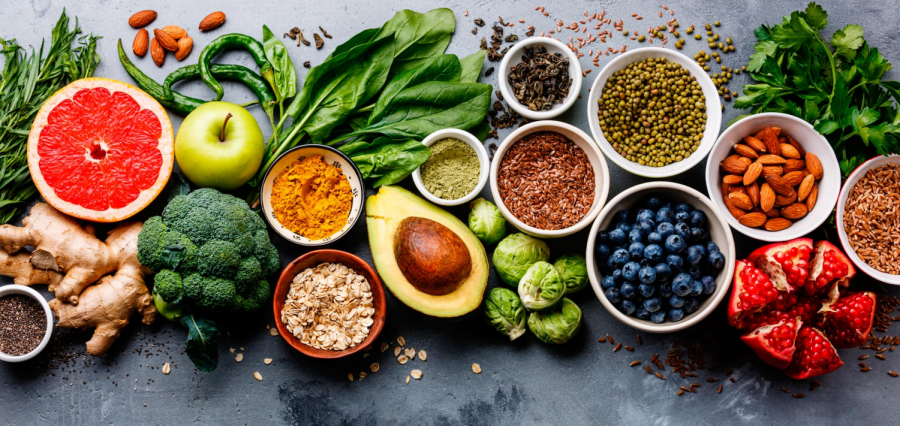Eating Well on Campus: Information and Tips
September 18, 2019
In the midst of school stress, it can be easy to forget about or just deprioritize eating healthy. If you add in the mixed messages about healthy eating that we are exposed to by various media sources, it is easy to get confused and give up on trying to eat healthy altogether. However, learning more about nutrition is one way to refocus and help us make more informed choices that meet our individual needs. This article will discuss some important aspects of nutrition and will provide tips on eating well.
What is nutrition? According to the World Health Organization, nutrition is simply defined as, “the intake of food, considered in relation to the body’s dietary needs.” Therefore, we eat food to fulfill known dietary needs in order to function properly. Although each individual is unique and may consume different types or amounts of foods based on health goals, dietary restrictions, or preference, the human body still requires basic nutrients.
Nutrients can be divided into two groups: macromolecules and micronutrients.
The three macromolecules include carbohydrates, fats, and proteins, which serve different functions. Carbohydrates are the body’s first source for energy. Some examples of foods that are made up mainly of carbohydrates are potatoes, bananas, and rice. Next, fats play a role in absorbing vitamins, storing energy, and providing insulation. Examples of foods with fat as the primary component are avocados, nuts, and eggs. Lastly, proteins play a significant role in building muscle and other tissues. Great sources of protein include meat, beans, and seeds (Maxliving, 2019).
Micronutrients, on the other hand, are composed of vitamins and minerals. There are 13 essential vitamins, each with at least one function. These can be found in whole foods, which are foods that have not been processed, or they can be found in nutrient-enriched foods and supplements. The National Institute of Health (NIH) lists the functions of each vitamin in the Medical Encyclopedia, which can be found online (MedlinePlus.gov, 2019).
While this topic could fill multiple books, here are examples of the bodily functions vitamins play meaningful roles in: Vitamin A helps form and maintain healthy teeth; Vitamin B6, and Vitamin E helps form red blood cells; Vitamin B12 and biotin (Vitamin B7) aid in metabolism; Vitamin C promotes healthy teeth and gums; Vitamin D helps the body absorb calcium for the maintenance of bones; Vitamin K helps blood coagulate; niacin (Vitamin B3) helps maintain healthy skin; folate (Vitamin B12) helps form red blood cells and produce DNA, pantothenic acid helps in metabolism; riboflavin (Vitamin B2) helps in body growth; thiamine (Vitamin B1) helps in carbohydrate metabolism; choline helps with brain function; and carnitine helps the body change fatty acids into energy.
According to the Hemophilia Federation of America (HFA), there are 16 essential minerals, which help in electrolyte balance, nerve functioning, making new cells, and delivering oxygen to cells, among other functions. Two important minerals are calcium, which contributes to bone and teeth formation, and iron, which helps carry oxygen to cells in the body (HFA, 2010). Vitamin and mineral deficiencies are fairly common, so it is important to go to regular check-ups with a doctor, especially if you are feeling weak or dizzy. It is also important to note that nutrients can be either essential or nonessential. Jacqueline Marcus, in her work, “Nutrition Basics: What Is Inside Food, How It Functions and Healthy Guidelines,” defines essential nutrients as nutrients that the body cannot make or produce in sufficient quantities.
Taking this into perspective, we once again see that we must consume certain foods in order to fulfill the body’s essential nutrient needs. Essential nutrients include the three macromolecules; fats, proteins, and carbohydrates, as well as water, certain vitamins, and minerals. In contrast, Marcus defines nonessential nutrients as nutrients that the body can make on its own or obtain from sources other than food and beverages. These include certain vitamins, cholesterol, and gastrointestinal bacteria (Marcus, 2013). How can we apply this information to eat well throughout our lives? Making sure to eat enough of the three macromolecules (protein, fats, and carbohydrates) is one part of eating well. Some diets may focus on eliminating one of these macromolecules, but while they may work for some, they may be difficult to maintain as a lifestyle.
Trying out different eating strategies also help, which include controlling the time of day, variations in preparation, and keeping a food diary. Some people feel better eating three larger meals through the day, while others feel better eating smaller portions more frequently throughout the day. Whatever the frequency, making sure to balance food choices and not to overindulge too often can help keep the body at its optimal condition. As the saying goes, “too much of a good thing can be a bad thing.” Specifically, it may be useful to reduce sugar and not to take too many vitamin supplements; supplements, too, can be dangerous and harmful for the body, and many nutrition experts recommend the intake of vitamins via food sources over supplements for maximum benefit.
Some UHart students have shared their tips and valuable advice on eating healthy, specifically on campus. Donavan Eaton, a current sophomore, suggests, “Take advantage of the various stations in commons such as the deli, kosher section, made-to-order option, and vegetarian section.” This is great advice, especially since eating a variety of meals can boost levels of different nutrients, as well as the increasingly important gut microbiota (the helpful bacteria in the intestines). We do not have to stay limited to the same food each day. We may even find our new favorite foods by exploring the options. Lashan Lee, a recent UHart graduate, also provides pointers on healthy eating. She mentions the new to-go container option at Commons, stating “You can get a to-go container with a key-card and leave with food. People are able to take a salad home so that they aren’t starving.” Using the to-go container can even help with portion control so that you do not feel pressured to eat too much in one sitting. She also states, “One thing I love about commons is that they have a fruit section, so you can always add fruit to your meals”, which would increase vitamin intake.
Someone’s knowledge about nutrition can vary from highly extensive to very minimal, but today, it is very easy to advance knowledge online. You can watch documentaries or videos about food, read articles from credible sources, or even take nutrition courses. Of course, be cautious of the source (i.e., do they benefit financially or otherwise from the message they are putting forth?). You may even decide to see a dietician or nutritionist. Eating food with others can be a fun way to celebrate and bond, but eating food is also a part of survival. If you feel that you may be experiencing an eating disorder, have digestive issues or illnesses, or have diabetes, going to health services on campus or going to a doctor can help substantially. Many medications and solutions are available to help treat and manage digestive problems. Whatever the case may be, many resources are available to help you reach any of your own goals, have a healthy mindset about food and help you feel your best.
PHOTO COURTESY OF EVERYTHINGZOOMER.COM










